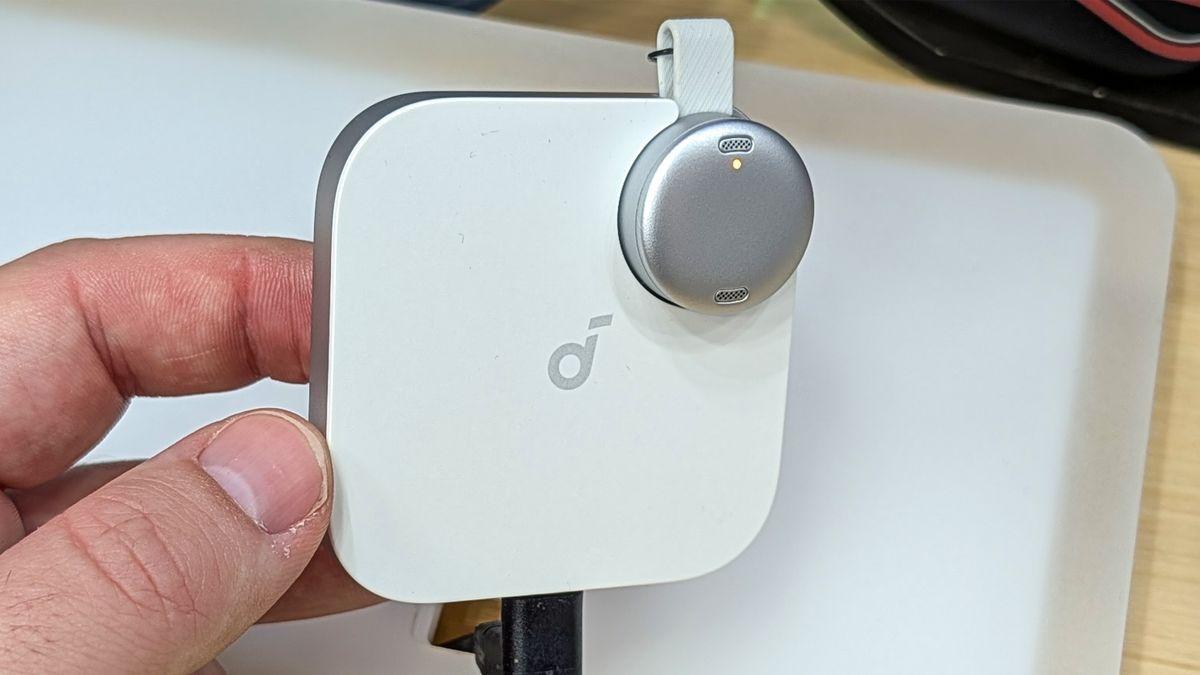Anker's Soundcore Work: A Coin-Sized AI Voice Recorder Sparks Debate on AI Integration
4 Sources
4 Sources
[1]
Anker's coin-size AI recorder can transcribe and summarize your meetings - in one click
The device can summarize and transcribe meetings automatically. Anker wants to make recording your meetings simpler than ever. The company announced its newest device today, the Soundcore Work. A small AI-powered voice recorder that's designed to be worn at meetings, the device can summarize and transcribe meetings and even highlight important parts. That alone isn't exactly unique, as other devices can do the same thing. What's special about the Work is its size. As reported by The Verge, the Work is 0.91 inches across, or about the size of a quarter. You can wear it on a lanyard or attach it to your clothing with a clip, and it has a battery life of about eight hours (32 hours if attached to its charger). Anker says the built-in speech recognition model is capable of transcribing more than 100 languages, and that the Work will automatically remove unwanted words and distinguish between speakers. It comes with a price tag of $100, The Verge said (a leak from AnkerInsider reflected a similar price point), and you can add a $16 per month subscription for additional features. It's not clear what those extra features are, but basic functionality is no extra charge. Anker hasn't said much about features (I've reached out for details), but the device is expected to have AI transcription and summarization, the ability to aggregate multiple meetings into a higher summary, and the ability to double-click the device to note key points. A French Amazon listing for the Work mentions that the Pro plan "offers 1,000 minutes of transcription per month," so the amount of time the device transcribes is at least one paid feature. The Amazon listing adds that the Starter plan includes 100 free minutes per month. There's no cable to worry about losing, as your meeting files are temporarily stored in the cloud and then automatically deleted after you download them. Anker added that the Work will use GPT-4.1 to transcribe audio recordings. Both the transcript and the original audio recording will be available in the Soundcore mobile app, and you can search to find information you need or export them to other formats. Similar devices already exist, like the Plaud Note and the TicNote from Mobvoi, but Anker's new device is significantly smaller (the Plaud and Mobvoi devices are each about the size of a credit card) and a little more affordable than other options (the Plaud and Mobvoi cost about $150). Those devices also have paid subscriptions.
[2]
Anker launches a tiny AI voice recorder with a hefty price tag
Google's NotebookLM is giving Audio Overviews new personalities Whether we like it or not, AI is here to stay and bound to become a bigger part of our lives in the coming years. While not all newly launched AI products impress us, some do just enough to capture our attention. Anker's new device has done just that. Ahead of the IFA 2025 tech exhibition in Berlin, Anker has unveiled the Soundcore Work, a nearly coin-sized (0.91 inches) AI recorder, which can record and transcribe conversations using dual microphones, with support for over 100 languages. Thanks to its AI prowess, powered by GPT 4.1, with a move to GPT 5.0 on the horizon, it can also summarize the recorded conversations to save you some time (via The Verge). The Anker Soundcore won't go easy on your wallets Anker will release the Soundcore Work in white and black colors later this month for $100, with global availability expected later in the year. In addition to the $100 you pay upfront, Anker will also offer a $16/month subscription with additional features, though the company didn't say what these additions are. Elsewhere on the features front, the Soundcore Work can run for up to 8 hours with its onboard battery, which is quite remarkable (if accurate). There's also a charging accessory provided by Anker that can reportedly take the total runtime of this AI recorder to 32 hours. The recorder weighs only 10 grams and attaches magnetically to your clothing, while it's also convenient enough to be worn on a lanyard. Anker addresses the lack of physical buttons on the Soundcore Work with tap gestures: a single tap to initiate the recording and a double-tap to mark or highlight a specific portion of the ongoing recording for later. The full audio recordings plus transcripts will be available from the Soundcore mobile app, and you can also share them with your peers. Anker lets you export the recordings and transcriptions into other formats, although we're yet to get all the details on what that looks like. As you would imagine, most of the heavy lifting happens behind the scenes, with encrypted audio recordings shared to Anker's cloud when a user initiates the transcription or shares the recording with someone. While there's plenty to love about the Soundcore Work, the fact that you need to pay $100 and then $16 per month to benefit from some of its additional (and yet unknown) features is likely to make some people skeptical. But as The Verge rightly points out, Anker's only competition in this segment comes from the Plaud NotePin and the Bee AI wearable, so the company might just be able to pull this off. What do you make of the Anker Soundcore Work?
[3]
This new AI voice recorder wants to be your affordable transcription device
Transcription has always been a useful thing to have for work and creative purposes, and that's only increased with greater access to AI models. There are already a handful of purpose-built devices you can buy for this, but the Soundcore Work is a new AI voice recorder that looks to have nailed all the practicalities beyond just recording audio and turning it into text. The Work debuted at IFA 2025 in Berlin, and will be rolling out to Soundcore's various international markets between September and November. You'll pay $99/£99 for the hardware, with the option of a $15.99/£15.99 monthly subscription for additional functionality, such as collecting transcripts on the same subject together with suggested to-dos and more. Recording begins with a simple press of the side button, with a light indicating to you and anyone you're speaking to that you've got a live mic on you. This isn't designed to be active 24/7 like some AI devices are meant to be - only when you need to specifically make use of it. Using dual mics, the Work promises to capture speech within a 5-metre (roughly 16-foot) radius, using GPT-4.1 (later to be upgraded to GPT-5) to provide what it says are 97% accurate transcription in over 100 languages. These are then processed into text in the cloud, but Soundcore promises that the data is deleted once the processed audio and transcript is delivered to the companion app on your mobile device of choice. The transcripts feature speaker ID and structured text for easy reading, focusing on any key passages that you've marked (via a double tap on the recorder), with these appearing at the top of the transcription for easy reference. A haptic buzz confirms you've done this, which is a smart way to confirm that your command registered without interrupting proceedings. Soundcore's specs say that the Work has a 10-day stand-by time, and can record for up to 8 hours, or up to 32 hours total when accounting for the charging cradle. With USB-C charging, you can apparently refuel the Soundcore Work fast enough in 10 mins to get 2 hours of recording. You can either have the coin-shaped recorder magnetically clipped to an included lanyard, or attached to your clothing like a traditional microphone. You can even keep it in the charging case while recording for marathon recording sessions, which you can then affix to the back of a MagSafe or Qi2-ready device to keep your stuff together in one convenient pile. That said, when you consider the recorder is only 0.91 inches across and weighs just 10 grams (0.35 ounces), it's not going to be that noticeable wherever you put it. It's also worth noting that the Work is rated IPX4 for water resistance, which is good news in the event you need to conduct your meetings or interviews out in the rain. The closest comparable device to the Soundcore Work is the Plaud NotePin, which comes with additional AI features and recording modes, but is also much more expensive, both in terms of hardware and optional subscription fees. The Soundcore Work's promised basic but comprehensive transcription system, plus its affordability, could encourage more users to try out an AI voice recorder, and potentially be the smarter buy overall. But we'll reserve full judgment for a future review. If you want to know what else has been on show at the Berlin Messe, check out our Best of IFA awards to see what exciting new tech there is across a variety of categories.
[4]
Anker's Soundcore Work AI Voice Recorder: Do We Really Need AI for Everything? - Phandroid
Anker just announced the Soundcore Work, a coin-sized AI voice recorder that costs $99.99 plus $15.99 monthly for premium features. It transcribes conversations in 100+ languages with 97% accuracy using GPT-4o, which sounds practical enough. But here's the thing: your phone already does most of this, and there are plenty of apps that handle transcription without buying another gadget. Sometimes it feels like companies are slapping "AI" on everything just because they can, not because we actually need it. The Anker Soundcore Work AI recorder weighs just 10 grams and offers 8 hours of battery life, extending to 32 hours with its charging case. You tap once to start recording, double-tap to mark important moments, and the AI handles transcription locally on the device. It's undeniably convenient, especially if you're constantly in meetings or interviews where you need accurate transcripts. Here's where things get annoying: that $15.99 monthly subscription adds up to $191.88 per year on top of the $99.99 device cost. For comparison, Otter AI charges $14.99 monthly and works with the phone you already own. There are also apps like TurboScribe offering unlimited transcription, or even free options like Google's built-in transcription that work surprisingly well for basic needs. We're seeing this pattern everywhere. Companies create AI-powered devices for problems that smartphones already solve, then charge recurring fees for features that feel incremental. The Soundcore Work might be useful for specific professionals who need dedicated recording hardware, but for most people, it's solving a problem that doesn't really exist. The device launches later this year, and Anker will likely find buyers among people who love gadgets or have very specific workflow needs. But it's hard not to wonder if this is just another example of the tech industry's obsession with adding AI to everything instead of making existing solutions better. Sometimes the simplest tools work just fine.
Share
Share
Copy Link
Anker unveils the Soundcore Work, a tiny AI-powered voice recorder capable of transcribing and summarizing meetings. While innovative, it raises questions about the necessity of AI in everyday devices.
Anker Introduces Soundcore Work: A Tiny AI-Powered Voice Recorder
Anker has unveiled its latest innovation, the Soundcore Work, a coin-sized AI voice recorder designed to simplify meeting transcription and summarization. Announced ahead of the IFA 2025 tech exhibition in Berlin, this device is set to hit the market later this month, promising to revolutionize how we capture and process spoken information
1
2
.
Source: ZDNet
Key Features and Specifications
The Soundcore Work boasts impressive capabilities packed into its diminutive frame:
- Size and Design: Measuring just 0.91 inches across and weighing a mere 10 grams, the device is comparable to a quarter in size
1
3
. - Recording Capacity: It offers up to 8 hours of recording time, extendable to 32 hours when used with its charging accessory
2
. - Transcription Capabilities: Powered by GPT-4.1 (with plans to upgrade to GPT-5.0), the device can transcribe conversations in over 100 languages with a claimed 97% accuracy
3
4
. - User Interface: The device features tap gestures - a single tap to start recording and a double-tap to highlight important points
2
. - Connectivity: Transcripts and audio recordings are accessible through the Soundcore mobile app
1
.
Pricing and Subscription Model
Anker has adopted a two-tier pricing strategy for the Soundcore Work:
- Hardware Cost: The device is priced at $99.99 (£99)
3
4
. - Optional Subscription: A $15.99 (£15.99) monthly subscription offers additional features, though the specifics of these features remain unclear
2
4
.
Market Position and Competition
The Soundcore Work enters a niche market with few direct competitors:
- Existing alternatives like the Plaud Note and the TicNote from Mobvoi are larger and more expensive, priced around $150
1
. - The Plaud NotePin offers additional AI features but at a higher cost for both hardware and subscription
3
.
Potential Applications and Target Users
The device seems tailored for professionals who frequently attend meetings or conduct interviews, offering:
- Automatic transcription and summarization of conversations
1
. - The ability to aggregate multiple meetings into a higher-level summary
1
. - Easy marking of key points during recordings
2
.

Source: Android Police
Related Stories
Debate Over AI Integration
The launch of the Soundcore Work has sparked a debate about the necessity of AI in everyday devices:
- Critics argue that smartphones and existing apps already offer similar functionality without the need for additional hardware
4
. - The recurring subscription model has been questioned, with some viewing it as an unnecessary expense for features that might be incremental
4
. - Supporters highlight the device's convenience, dedicated purpose, and advanced AI capabilities as justifications for its existence
3
.
Privacy and Data Handling
Anker has addressed potential privacy concerns:
- Recordings are temporarily stored in the cloud and automatically deleted after download
1
. - The company promises that data is encrypted and deleted once processed and delivered to the user's device
3
.

Source: Tom's Guide
As the Soundcore Work prepares for its global rollout, it remains to be seen whether its unique blend of AI capabilities and compact design will resonate with consumers or if it will be viewed as another example of unnecessary AI integration in everyday tools.
References
Summarized by
Navi
[2]
Related Stories
AI-Powered Earbuds Revolutionize Recording and Translation: Viaim RecDot Combines Audio and AI Technology
06 Mar 2025•Technology

Plaud Launches Note Pro: A New Era in AI-Powered Note-Taking Devices
28 Aug 2025•Technology

PLAUD's AI-Powered Note-Taking Devices: Revolutionizing Information Management
10 Dec 2024•Technology

Recent Highlights
1
AI Chatbots Sway Voters More Effectively Than Traditional Political Ads, New Studies Reveal
Science and Research

2
OpenAI declares code red as Google's Gemini 3 gains 200 million users in three months
Technology

3
Trump approves Nvidia H200 chip exports to China with 25% revenue cut, defying Senate concerns
Policy and Regulation





